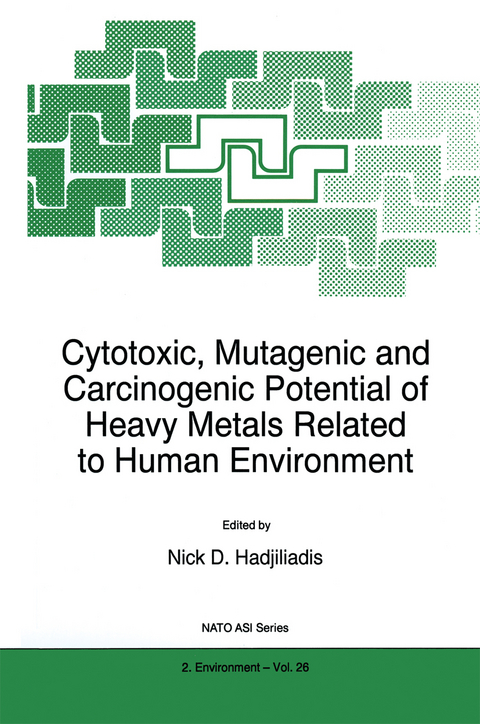
Cytotoxic, Mutagenic and Carcinogenic Potential of Heavy Metals Related to Human Environment
Springer (Verlag)
978-94-010-6440-8 (ISBN)
The idea underlying the present work is therefore to present a multidisciplinary perspective on heavy metals in the environment, affording a better understanding of their action on human organisms and health, aiming to make them less polluting and more environmentally friendly.
Metal Carcinogenesis.- Zinc Finger-DNA Interaction: Effect of Metal Replacement, free Radical Generation and DNA Damage and its Relevance to Carcinogenesis.- Pathways in the Chromium(VI)-Mediated Formation of DNA Lesions: A Review.- Approaches to the Biological Monitoring of Chromium(VI) Exposed Individuals.- The Mechanisms of Metal Carcinogenicity Chromium(VI)-induced Genotoxicity: Direct and Indirect Pathways.- The Oxidative Damage Hypothesis of Metal-Induced Genotoxicity and Carcinogenesis.- Effects of Calcium, Magnesium, Zinc and Iron on Nickel Carcinogenesis: Inhibition Versus Enhancement.- Modelling the Metal Binding Sites in Core Histones: Interactions of Carcinogenic Ni(11) with the -CAIH-Motif of Histone H3.- Perinatal Effects of Metals and Cancer in Offspring.- Metallothioneins.- Spectroscopic Properties of Ag(l), Cd(ll), Cu(l), Hg(ll) and Zn(ll) Metallothioneins.- Diversity of Cluster Structures in Mammalian Metallothionein: Interplay Between Metal Ions and Polypeptide Chain.- Metallothionein in Cytotoxicity and Genotoxicity of Metals.- Biological Role of Aluminium.- Aluminium(lll) Speciation and Biological Effects Implications in Human and Experimental Toxicity.- Interaction of Al(lll) with Biomolecules: Bioinorganic Chemistry and Biological Implication.- Complexes of Aluminium(lll) with Biologically Important Ligands.- Bioinorganic Chemistry (General).- Bioinorganic Aspects of Lanthanide(lll) Coordination Chemistry: Modelling the Use of Lanthanides(III) as Probes at Calcium (II) Binding Sites.- From the Mass Production of Methvlococcus Capsulatus to the Efficient Separation and Isolation of Methane Monooxygenase Proteins. Characterization of Novel Intermediates in Substrate Reactions of Methane Monooxygenase.- Modeling Manganese Redox Engymes.- Metal Transport.- Li+ Transport Properties in Perfused Neuronal Cells By 7Li NMR Spectroscopy.- Active Efflux Mechanisms for Cellular Resistance.- Transferrin: A Natural Carrier for Metal Ions and Drugs.- Heavy Metals in the Environment.- Human and Ecological Health Risks from Heavy Metals and Other Substances Released to the Environment from Metal Shredders.- Analytical Applications of Vibrational Spectroscopy in Bioorganometallic Chemistry.- Advanced Techniques for Bioinorganic and Environmental Speciation Analysis for Heavy Metals.- A Heavy Metal Pollution in Industrial Lone and Its Effect on Soil and Spring Water in Iskenderun Bay, North East Mediterranean.- Antitumor Metal Complexes.- Mechanistic Aspects of Pt Antitumor Chemistry.- Factors Affecting Formation and Structure of DNA Intrastrand Cross-Links by Dinuclear Platinum Complexes.- Tin-Based Antitumor Drugs.- Ruthenium-Sulfoxide Complexes with a Specific Antimetastatic Activity.- Synthesis, Spectroscopy and Structures of Complexes of Pd(ll) with 4N-Substituted Derivatives of 2-Acetylpyridine Thiosemicarbazone.- Metal Interactions with Oligonucleotides and Oligopeptides.- Design of Proteins with ATCUN Motif Which Specifically Cleave DNA.- The Binding of Transition Metal Ions to DNA Oligonucleotides Studied by Nuclear Magnetic Resonance Spectroscopy.- Pyrimidine Nucleobases as Versatile and Multidentate Ligands for Heavy Metal Ions. Significance of Metal Binding to the C(5) Sites of Uracil and Cytosine.- Potentiometric and Spectroscopic Studies on the Ternary Complexes of Copper(ll) and Palladium(ll) with Peptides and Nucleobases.- Metal Binding Selectivity of Oligopeptides.- Bioinorganic Chemistry of Toxic Nickel.- Interaction of Platinum(ll), Palladium(ll) and Mercury(ll) Salts with Histidine (His) and/or Cysteine (Cys) Containing Peptides.- General Subjects.- Electrochemical and Chemical Oxidation of K(C2H5OCS2), [Ni(C2H5OCS2)2] and [N(C2H5)4][Ni(C2H5OCS2)3].- Transport of Biomimetic Multinuclear Complexes of Manganese into Environmental Abudant Clays.- Sequential Oligopeptide Carriers (SOCn) for Producing Potent Antigens and Effective Immunogens.
| Reihe/Serie | NATO Science Partnership Sub-Series: 2 ; 26 |
|---|---|
| Zusatzinfo | XXIV, 629 p. |
| Verlagsort | Dordrecht |
| Sprache | englisch |
| Maße | 160 x 240 mm |
| Themenwelt | Medizin / Pharmazie ► Medizinische Fachgebiete ► Onkologie |
| Studium ► Querschnittsbereiche ► Prävention / Gesundheitsförderung | |
| Naturwissenschaften ► Biologie ► Biochemie | |
| Naturwissenschaften ► Biologie ► Ökologie / Naturschutz | |
| Naturwissenschaften ► Chemie ► Anorganische Chemie | |
| ISBN-10 | 94-010-6440-7 / 9401064407 |
| ISBN-13 | 978-94-010-6440-8 / 9789401064408 |
| Zustand | Neuware |
| Haben Sie eine Frage zum Produkt? |
aus dem Bereich


